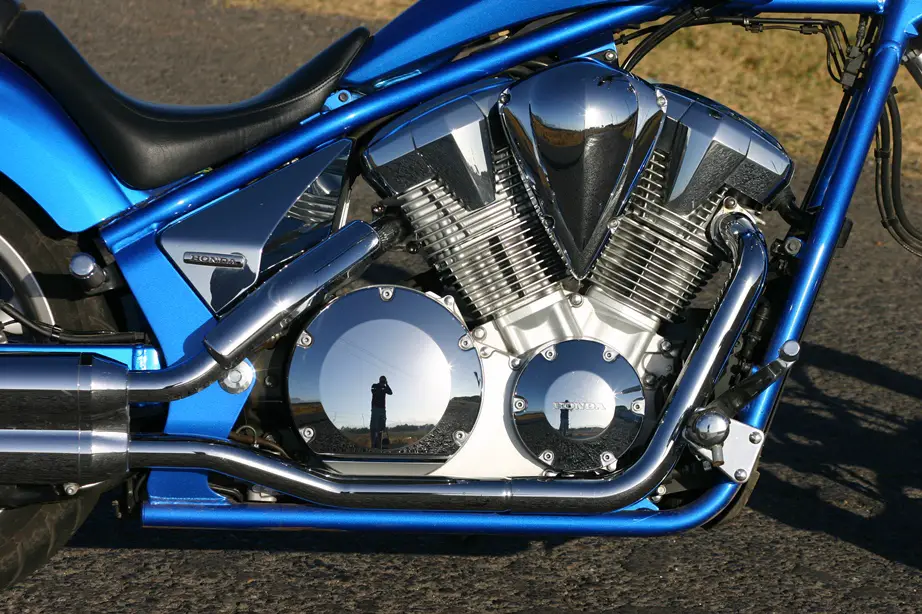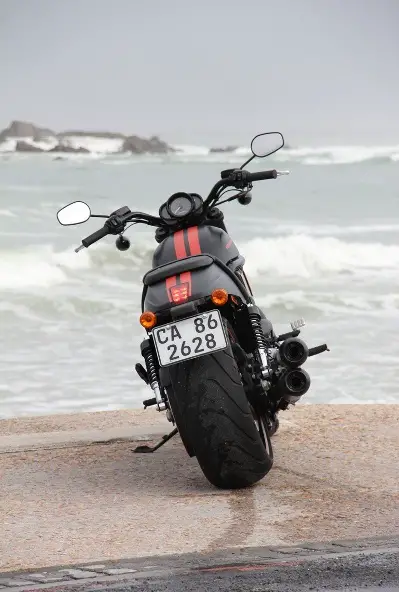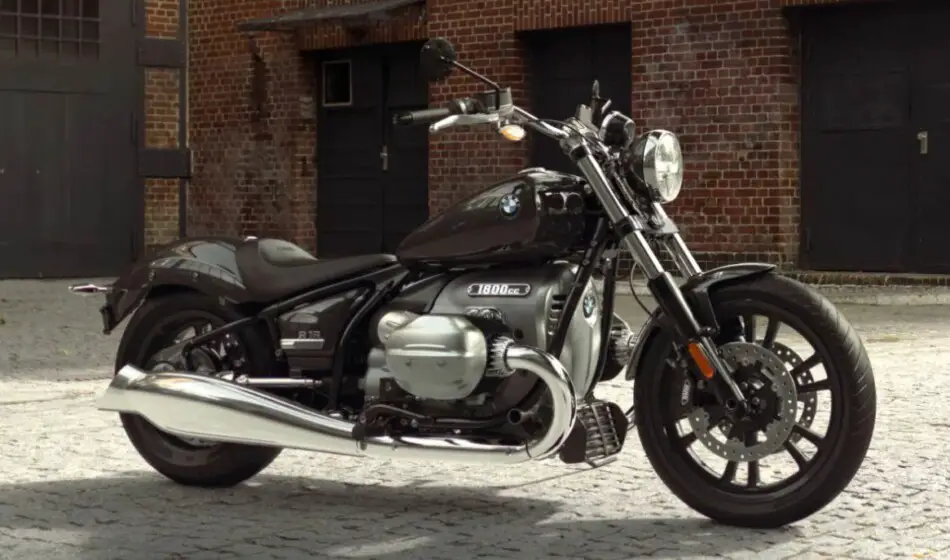If you’ve ever parked a Harley Davidson (or any cruiser bike for that matter) with its front wheel against the sidewalk, you’ll know these bikes are not easy to move around with your legs. They are heavy!
The average cruiser motorcycle weighs 593 lbs (269 kg) fully fueled, which is the same as the heaviest adventure bike (BMW R 1250 GS Adventure) or street bike (Kawasaki Ninja ZX-14R). The BMW R18 Classic is the heaviest cruiser bike at 805 lbs (365 kg) and the Yamaha V Star 250 is the lightest cruiser weighing only 324 lbs (147 kg).
Let have a look at some reasons why cruisers are so heavy.
Cruisers Have Large Engines and Transmissions
Cruiser motorcycles generally have larger engines than other types of bikes. Most Harley Davidson’s these days run the Milwaukee-Eight Big Twin 114 cubic inch (1 868 cc) engine. BMW’s new R18 Classic cruiser has a 1 802 cc engine and the Suzuki Boulevard M109R B.O.S.S. is powered by a big 109 cubic inch (1 793 cc) motor.

These top-end cruisers have engines nearly double the capacity of the top-of-the-range sports bikes. All the major manufacturers of superbikes ‘only’ have liter motors, like the Yamaha YZF-R1 and the Honda CBR 1000 RR (both 998 cc), yet they go much (MUCH!) faster than the average big cruiser.
Cruiser motorcycles generally have air-cooled push-rod engines that cannot rev as high as sports bikes. Low rpms mean lower power, which in turn requires more torque to get these heavy machines to move. That is why cruisers need large displacement engines that weight them down.
For a more detailed post on why cruisers are so slow and underpowered compared to other street bikes, see this post I wrote.
Large engines require large transmissions which adds considerable weight to an already heavy engine.
Cruisers are not Designed to be Lightweight
So cruisers have large engines that cannot rev as high as sports bikes. Why?
Cruiser motorcycles are not designed to wiz around a race track at breakneck speed. Cruisers are also not designed to be light and nimble. Instead, cruisers are made to cruise down the highway or leisurely ride along the twisting roads at the coast.
Cruisers are designed to make a statement. They make a lot of noise, have lots of shiny chrome, and demands attention. Manufacturers spend money on shiny exhaust pipes, fat wheels, and wide handlebars instead of weight saving plastics and narrow dimensions.

The big, heavy twin-cylinder needs a strong, sturdy (and heavy) chassis to carry the weight. Cruisers tend to attract heavy riders and pillions as well, although I doubt that that is part of their design or marketing strategy.
Cruiser Styling and Accessories
Along with the engine and chassis design, cruisers are often customized by their riders to create an individual look. You’ll rarely see two Harley Davidsons that look exactly the same. Custom seats, pipes, handlebars and saddlebags all add to the weight of these already heavy machines.
How Heavy are Cruiser Motorcycles Really?
So we’ve mentioned that cruisers are heavy, but how heavy are they really compared to other types of motorcycles?
Interestingly, cruisers are not the heaviest category of motorcycle out there. That honor (or disgrace, you decide!) goes to the touring bikes. The average touring motorcycle weighs 798 lbs (362 kg) which is just shy of the heaviest cruiser at 805 lbs.
Cruiser motorcycles weigh between 324 lbs for the Yamaha V-Star 250 and 805 lbs for the BMW R18 Classic. The average cruiser weighs 593 lbs (269 kg) which is more than the heaviest adventure bike. In fact, 75% of all cruisers on the list below weigh more than the average adventure bike.

The table below shows the curb weight (fully fueled and ready to ride) – in lbs and kg – of 39 of the most popular cruiser motorcycles from Harley Davidson and the four Japanese manufacturers.
| Bike | Curb Weight (in lbs) | Curb Weight (in kg) |
| BMW R 18 Classic | 805 | 365 |
| Suzuki BOULEVARD C90T | 800 | 363 |
| Suzuki BOULEVARD M109R B.O.S.S. | 764 | 347 |
| BMW R 18 | 761 | 345 |
| Suzuki BOULEVARD C90 B.O.S.S. | 758 | 344 |
| Harley Heritage Classic | 728 | 330 |
| Suzuki BOULEVARD M90 | 723 | 328 |
| Harley Fat Boy 114 | 699 | 317 |
| Harley Sport Glide | 699 | 317 |
| Harley Low Rider S | 679 | 308 |
| Harley Fat Bob 114 | 676 | 307 |
| Harley Softail Slim | 671 | 304 |
| Honda FURY | 663 | 301 |
| Harley Streetbob 114 | 659 | 299 |
| Kawasaki VULCAN 900 CLASSIC LT | 657.1 | 298 |
| Harley Softail standard | 655 | 297 |
| Suzuki BOULEVARD C50T | 644 | 292 |
| Kawasaki VULCAN 900 CLASSIC | 619.6 | 281 |
| Suzuki BOULEVARD C50 | 611 | 277 |
| Kawasaki VULCAN 900 CUSTOM | 610.8 | 277 |
| Suzuki BOULEVARD M50 | 593 | 269 |
| Honda SHADOW AERO ABS | 573 | 260 |
| Harley Iron 883 | 564 | 256 |
| Harley Iron 1200 | 564 | 256 |
| Honda SHADOW AERO | 560 | 254 |
| Harley Forty-eight | 556 | 252 |
| Honda SHADOW PHANTOM | 549 | 249 |
| Yamaha Bolt R-Spec | 542 | 246 |
| Honda REBEL 1100 DCT | 509 | 231 |
| Harley Sportster S | 502 | 228 |
| Kawasaki VULCAN S | 496.1 | 225 |
| Kawasaki VULCAN S CAFE | 496.1 | 225 |
| Honda REBEL 1100 | 487 | 221 |
| Honda REBEL 500 ABS | 414 | 188 |
| Honda REBEL 500 | 408 | 185 |
| Suzuki BOULEVARD S40 | 381 | 173 |
| Honda REBEL 300 ABS | 370 | 168 |
| Honda REBEL 300 | 364 | 165 |
| Yamaha V Star 250 | 324 | 147 |
While most cruisers weigh more than 500 lbs (227 kg), there are some light weight cruisers for beginner riders. The smaller capacity Honda Rebels (300 and 500 cc), the Suzuki Boulevard S40 (652 cc single), and the Yamaha V-Star 250 all weigh between 300 and just over 400 lbs.
The only cruiser with a larger engine (1 084 cc) that weighs less than 500 lbs is the Honda Rebel 1100.
Are Heavy Cruisers Difficult to Ride?
Although cruisers are very heavy, they have a low center of gravity. Cruisers also have very low seats (check out my detailed post of cruiser seat heights here) which makes it much easier to plant both feet firmly on the ground on either side of the bike.
The combination of a low seat height and low center of mass make cruisers easier to ride than other motorcycles, especially for shorter riders or beginners. The ability to put both feet firmly on the ground reduces the risk of dropping the bike. The backward-leaning seating position and high handlebars on cruisers take some getting used to if you’ve never been on a cruiser before.
Even though cruisers are very heavy, the large amount of torque delivered by the big engine requires very little rider input to pull away. While the torque is ample, the delivery is generally smooth, linear, and controllable. There is no ‘power band’ or surge at higher rpms like you find on a dirt bike or sports bike.
These characteristics are what make them fun to ride. A cruiser has strong acceleration accompanied by a lot of noise, but not enough much speed to get you into serious trouble. That doesn’t mean a cruiser won’t do illegal speeds. You can do 80 mph on a Harley Davidson Fat Boy, but it is not going to comfortable as the wind uses your upright body as a sail to pull your outstretched arms from the tall handlebars.
No! Cruisers are meant to cruise and make a statement (and a lot of noise). Just enjoy it!
Conclusion
Cruisers are definitely on the heavy side compared to other types of motorcycles and they tend to have very large engines. However, due to the low center of gravity and low seat height, cruisers are not that intimidating to ride.
Bikers that ride other types of motorcycles tend to look down on cruisers and make fun of them for being loud and showy, yet slow. Maybe I am one of them. But every time I get on a Harley Davidson I understand why riders love them. There is something about that backward seating position and the loud, uneven idle, vibrating between your legs.
Do yourself a favor and try it sometime!
Ps. if you want to know why Harley’s idle so rough, check out this post.
